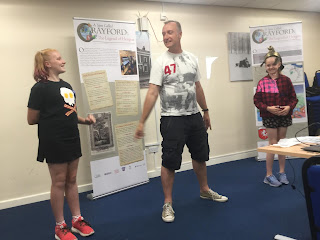Popular posts from this blog
SummerFilm Project: Introduction to Anglo Saxons - Oscar Hudson
On Thursday 26/07/2018 we began the CRAY Summer Film Project. Pete introduced the project and began by explaining the Saxon invasion. It was very interesting to see where they invaded our country and how they affect our daily lives. Such as: day names and names of counties. We then looked at some old Saxon maps which easily translated onto modern day maps of the area. We also looked at the fall of the Roman empire through coin investigation which made the Britons susceptible to invasion. Pete then explained the story of Hengest and Horsa, and the battle of Crayford. In the afternoon the kids got hands on with the film cameras they'll be using for the rest if the week They were taught the basic rules of filming. White balance Iris Framing Focus LEvel of sound These skills will be vital for the rest of the week and they have all excelled. This bodes well for the quality of the film. We are all looking forward to the rest of the project and what the...
A journey around Anglo-Saxon histories and mythologies
From Crayford to Pegwell Bay, on Monday 30 July we (Beth and Fran, King’s College London) led the intrepid CRAY group around five sites associated with the founding legend of the arrival of Anglo-Saxons in Britain. Some of the sites were important to the Anglo-Saxons, and we know this thanks to archaeological or textual evidence. However, Some of the sites became linked with stories of the Anglo-Saxons later centuries, or even in the last 100 years. The children all thought about the difference between history and stories, why we remember the past, and made some fantastic creative work in response to the places we visited. St Paulinus Church A church has stood at this site since at least the 9th century according to archaeological remains, and it’s mentioned in the 1086 Domesday survey ordered by William I (the Conqueror). However, it’s likely that the site has been important for much longer. As the children noticed, the church is on a high point overlooking...



Comments
Post a Comment